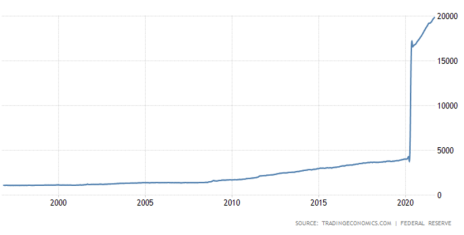Inflation is back. And it looks like it might be for real this time. To weather it, you’ll need a couple dividend stocks for high inflation in your portfolio. I’ll get to those in a bit.
Every 10 years or so inflation pops up and becomes a popular topic among the financial pundits. But any inflation that has occurred for the last several decades proved to be very temporary. In fact, inflation hasn’t been a real problem in 40 years. But it might be a big problem again.
In October, the inflation rate, as measured by the Consumer Price Index, rose to 6.2%, the highest year-over-year inflation in 31 years. It was also the sixth straight month of inflation growth of more than 5%. Many believe the numbers will only get worse in the months ahead (November numbers had not been released as of this writing).
[text_ad]
The Fed had originally labeled this inflation as “transitory.” Most economists had assumed this inflation to be a temporary situation as well. But it is proving much more stubborn and longer lasting than they had anticipated. Forecasts are changing and the word “transitory” is being expunged as an adjective to describe this inflation.
The common belief had been that this is a temporary aberration caused by the pandemic. The rapid crash and restart pandemic economy has broken supply chains. And many products aren’t making it to market. At the same time, consumers are flush with cash and pent-up demand.
The high demand and limited supply dynamic is a recipe for rising prices. Many assume that the supply issues will get worked out as the recovery continues. Supply will again match demand and this inflation will fade. That may turn out to be the case, but maybe not.
Rising prices can be a phycological phenomenon as well as an economic one. Once that inflation genie gets out of the bottle it can be difficult to get it back in. There are also reasons why inflation could be a lot stickier now than in past decades.
Inflation is commonly defined as “too much money chasing too few goods.” I’ve already touched on the too-few-goods part. Supply chains are delicate and often begin overseas where things tend to be more screwed up. Supplies aren’t yet keeping pace with the cash rich consumer.
Now, let’s talk about the too-much-money part of the inflation equation.
People are back to work for the most part and the consumer is back in business. But aside from the economic recovery there’s something else. The federal government has pumped about $6 trillion into the economy in relief since the start of the pandemic, and there’s more on the way.
The above chart, courtesy of Trading Economics, measures money supply by the “M1” definition. This is the most liquid measure for money supply and includes currency in circulation, travelers checks and checking accounts.
As you can see from the chart, the money floating around has skyrocketed since the pandemic. That’s what they mean by “too many dollars.” Even if the supply chain recovers and matches demand, there are still far more dollars floating around than before. It’s a safe bet that demand won’t rise to the extent the money supply has from pre-pandemic days.
Even the more skeptical economists now admit that this inflation will last a while. Whether it lasts many years or just one year, it’s worth having investments that can hold up and even thrive amidst rising prices. Here are two investments that should benefit from the new inflation.
Dividend Stock for High Inflation #1: Valero Energy (VLO)
Yield 5.5%
Oil and gas are essential commodities, the prices of which tend to outperform inflation. Energy companies tend to thrive during times of inflation as the price of oil and gas tends to rise a lot more than the costs of extracting it and bringing it to market. The energy Select Sector SPDR Fund (XLE), which tracks stocks in the S&P 500 energy sector, is up 46% in 2021.
Energy stocks got creamed during the pandemic and a big part of the high returns over the past year was a recovery from absurd lows as the lockdowns ended and demand returned. But now, the sector is getting a boost from rising energy prices and the stock’s ability to perform during inflation.
Valero is the largest petroleum refiner in the U.S. It has 15 petroleum refineries and markets products in 43 states, Canada and the U.K. It is also one of the largest producers of ethanol and has a rapidly growing renewable diesel business.
As demand for gasoline and diesel crashed during the pandemic, VLO fell 70% from the all-time high. But things are reversing in a big way. VLO is up 25% this year, despite recent Omicron-driven weakness.
Third-quarter revenue soared 87% from the year-ago quarter and profits flipped from a negative-$464 million to a positive-$463 million over the same period. Sure, crude oil is a cost and the price per barrel is way up. But so is the price of gasoline, which has more than doubled over the past year. Valero is good at making sure the margins are still high. And the robust demand and prices of refined products should stay strong in the quarters ahead.
But you haven’t missed the boat. VLO still trades 16% below the the 52-week high, 29% below the pre-pandemic high, and 42% below the all-time high. This refiner should have a lot more room to run.
Dividend Stock for High Inflation #2: Chevron (CVX)
Yield 4.7%
Much of what I said about the cyclicality and pricing of VLO is true for CVX as well, except to a lesser extent. Chevron is the best run oil major with high margins and can more quickly turn a profit as things improve. It didn’t go down as much as VLO and has gone up less too. But the gist of the move is the same.
Chevron started the pandemic in much better shape than its peers and weathered the storm better. The company has done a stellar job of getting leaner and meaner over the last several years. Chevron’s cost per dollar of BOE (barrel of oil equivalent) produced has fallen from $18 in 2014 to under $10 today. Chevron has lower costs and higher margins than its peers.
The oil giant also hit this recession right. It completed several large projects in the past several years and had already winded down capital expenditures.
There’s an important thing to realize about Chevron. It is skewed more heavily toward oil exploration and production and is more leveraged to oil prices than the other energy majors. It’s loving the current environment. Third-quarter revenues skyrocketed to $6.1 billion, the highest since 2013. Cash flow of $6.7 billion for the quarter was the highest ever.
Yet, despite the stellar performance, CVX is still below the pre-pandemic price. The good times should continue to roll for CVX, which received a slew of analyst upgrades after the third-quarter report.
Have you bought any stocks specifically as a hedge against inflation?
[author_ad]
*This post has been updated from an original version.

